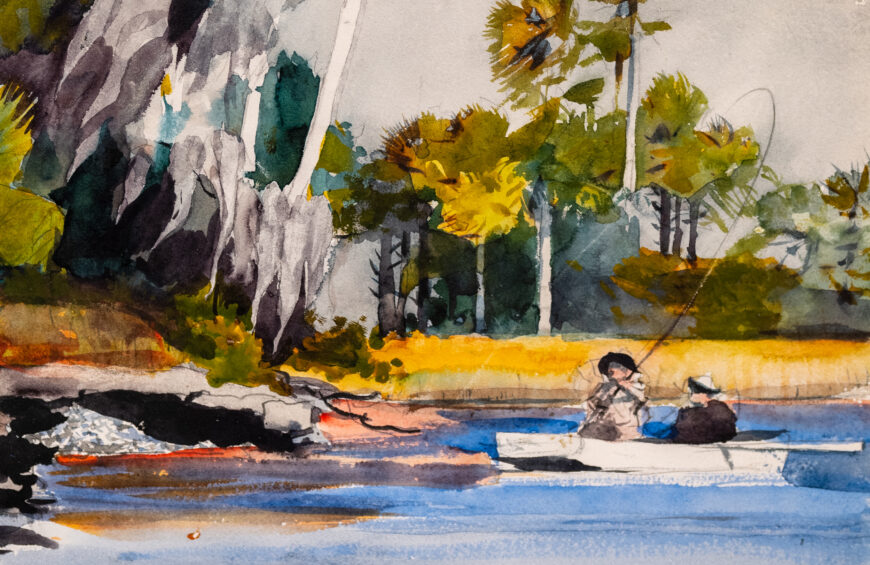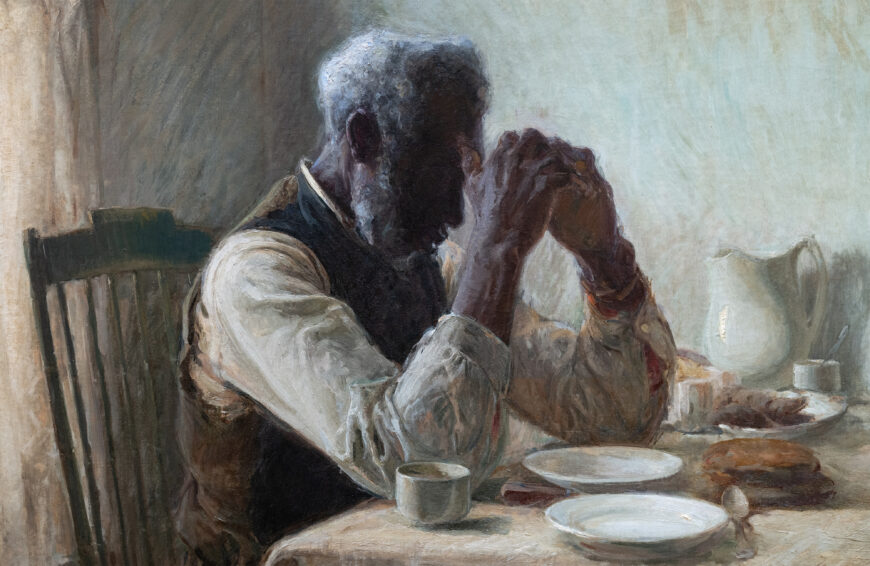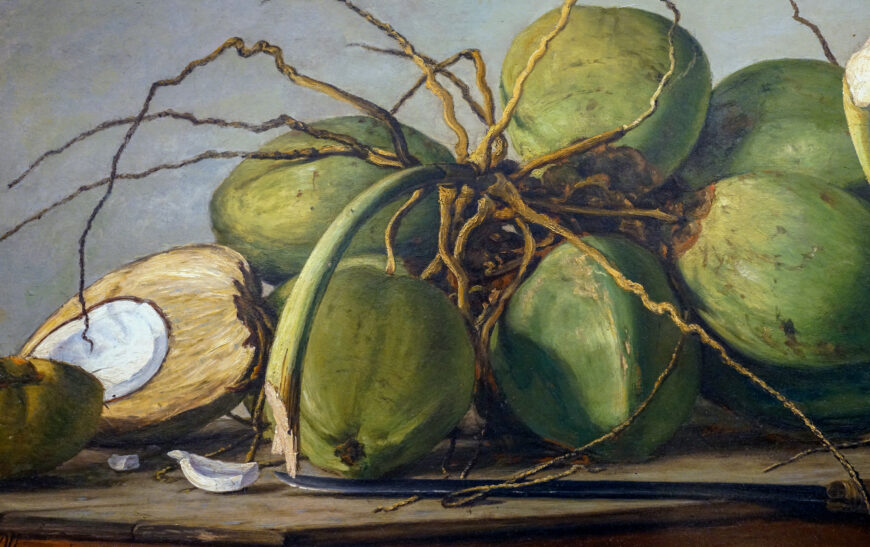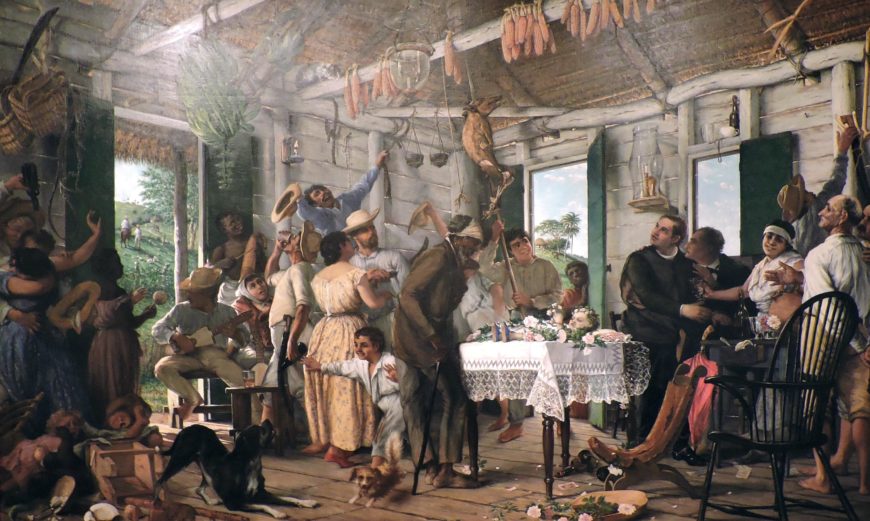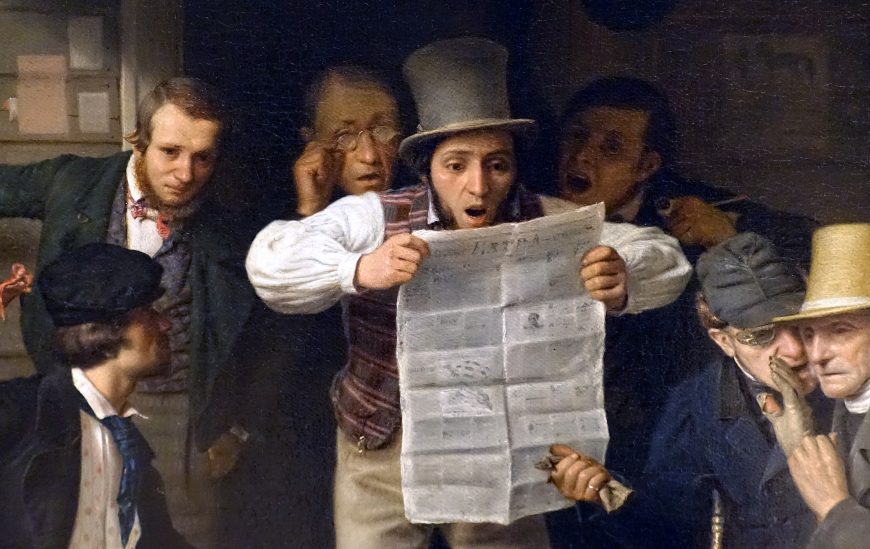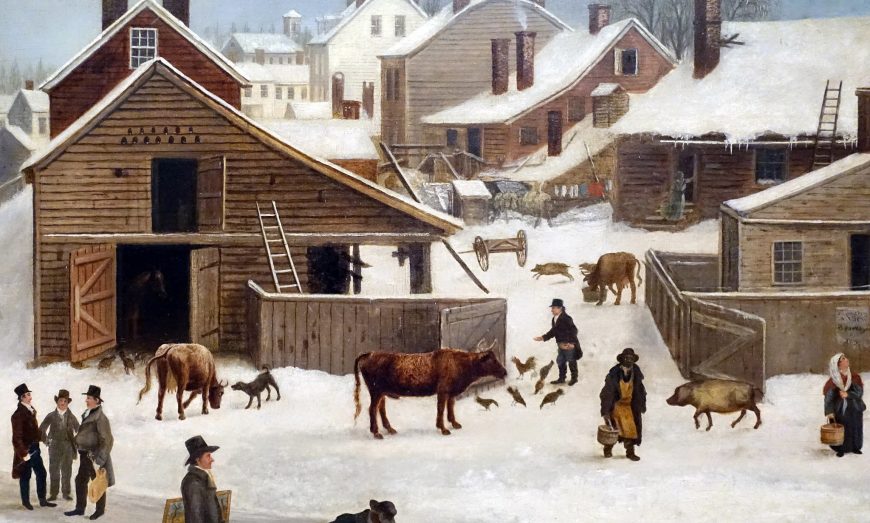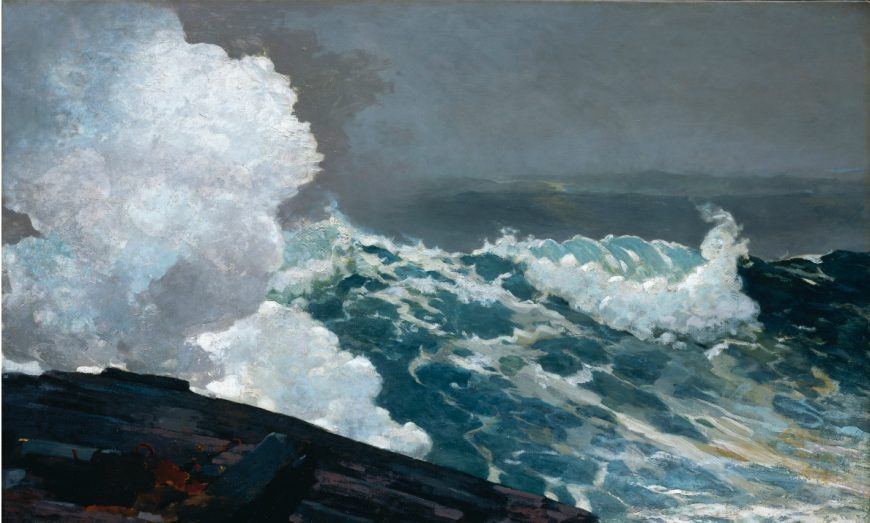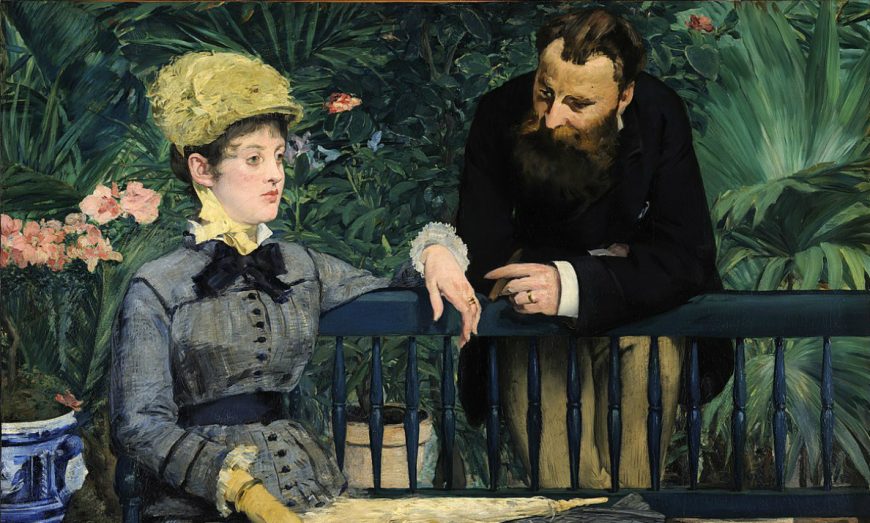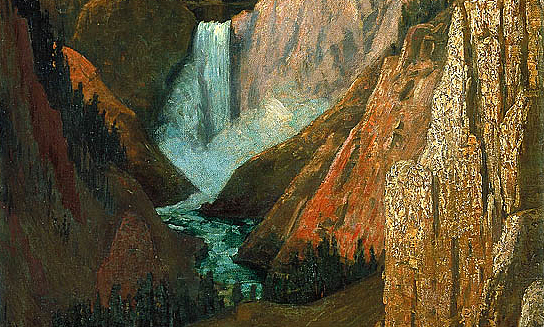Thomas Hovenden, The Last Moments of John Brown, c. 1884, oil on canvas, 117.2 x 96.8 cm (de Young Museum, Fine Arts Museums of San Francisco)
A Seeing America video
Thomas Hovenden, The Last Moments of John Brown
[0:00] [music]
Dr. Steven Zucker: [0:04] We’re in the de Young Museum, part of the Fine Arts Museums of San Francisco, looking at a painting called “The Last Moments of John Brown,” by Thomas Hovenden.
Dr. Lauren Palmor: [0:17] The painting was made 25 years after the execution of John Brown.
Dr. Zucker: [0:22] We still don’t know what to do with John Brown. He’s such a complicated and controversial figure. He’s heroized, almost sainted, but also seen as a murderer.
Dr. Palmor: [0:32] At the museums, we like to ask visitors a more pointed version of that: was he a martyr or a terrorist?
Dr. Zucker: [0:39] John Brown attacked the federal armory at Harpers Ferry, with the idea that he could distribute the muskets, the arms that were there to Black slaves in the South, inciting a broad rebellion, but this was only the final act by John Brown over the course of a couple of years where he used violence to try to end slavery.
Dr. Palmor: [0:57] The raid on Harpers Ferry takes place on October 16th, 1859. In very quick succession, John Brown is captured, imprisoned, tried, and sentenced to death.
Dr. Zucker: [1:09] And within two months, executed.
Dr. Palmor: [1:12] In that two-month period, people across the United States debated — were his actions just? Was he brave? Was he a madman? A danger to our politics, to our values? And even today, we don’t agree.
Dr. Zucker: [1:26] This event forced people to choose sides. It hardened people’s opinions and is seen by historians as leading to the decision by the South to secede. But even Northerners, even abolitionists, were concerned about John Brown’s violent methods. Abraham Lincoln tried to distance himself, calling John Brown insane.
[1:47] Yet John Brown was trying to use force, to use violence, to undo the violence that was an everyday occurrence of the slaveholding states of the United States.
Dr. Palmor: [1:57] 1859 was a year running up to a presidential election. Just as news cycles move today before a presidential election, people make their feelings known. Running up to this election, people were asking themselves, which side did they stand on?
[2:12] When Lincoln is elected in 1860, those who felt strongly that John Brown was acting in the name of all that was good and just, they began seeing a very different America from those who did not vote for Lincoln.
Dr. Zucker: [2:25] So, if this event had been portrayed by a Southerner who was sympathetic to slavery, we would see a very different painting. This was made by an artist who is clearly sympathetic to the actions of John Brown and paints him here with a noose around his neck, with his arms bound, on his way to his execution, having the presence and tenderness to stop and kiss a child, specifically a Black child.
[2:51] I love the way the figure just to the left of the sheriff peeks over his shoulder to get a glance at the kiss that’s unfolding. There has been lots of debate as to whether or not that kiss actually took place. It seems extremely unlikely that people were allowed anywhere near John Brown, and yet newspaper reports and an early poem do depict that kiss.
Dr. Palmor: [3:11] The story of the kiss is traced back to an article for the “New York Tribune” written a few days after the execution and attributed to Edward H. House. After the story spread and became mythologized through poetry and print, House said he actually had nothing to do with the story.
Dr. Zucker: [3:30] Now, that doesn’t mean that the kiss didn’t happen, but it does mean that we don’t have direct evidence. There is such care in the representation of each of the figures in this painting.
Dr. Palmor: [3:40] The expression of the little girl who’s holding onto the skirts of her nanny or caretaker, she looks up at John Brown with a great sense of understanding. Of all of the white figures in this scene, she seems to see him in the same light as those he fought to free.
Dr. Zucker: [3:57] She is, in a sense, an embodiment of innocence and morality, and is in such contrast to the soldier who stands at the lower left who’s using his rifle to block the crowds and looks off at the Black man just to his right with incredible disdain.
[4:13] All four of the bayonets express a kind of latent violence, and so there’s this wonderful contrast with the deep humanity that is seen in the figure of Brown himself. John Brown here is shown as a martyr, as a quasi-religious figure, that long white beard reminiscent of the way that Moses is portrayed. Critics have noted that there’s a subtle cross in back of the figure.
Dr. Palmor: [4:36] Once you see that cross, you understand the story that Hovenden is trying to get you to see.
Dr. Zucker: [4:42] Here was a white man willing to take enormous risks in order to free African Americans in bondage, and it’s interesting to think about how historians have looked at him. He had been heroized in the Northern press in the years during the Civil War.
[4:57] In fact, a song called “The Body of John Brown” was sung by Union troops as they marched. But by the time we get to the First World War, historians tend to look at John Brown in a very negative light. That is only reversed in the last 10, perhaps 20 years.
Dr. Palmor: [5:13] But Brown also had his friends and supporters in his lifetime who fought very hard to have him remembered in a different way. Fredrick Douglass referred to him, even after his execution, as Captain Brown.
Dr. Zucker: [5:25] Harriet Tubman actually tried to find volunteers to help support his attack at Harpers Ferry.
Dr. Palmor: [5:30] We should also say something about where we are as the viewer. We’re just far back enough that we can make out the curb at the edge of the jailhouse steps. Are we jailers? Are we in the crowd? Are we sympathetic supporters? Are we part of the militia, ready to escort him to the gallows?
Dr. Zucker: [5:50] What Hovenden has done is parted the crowd for us. We’re given this privileged view. The artist has given us access to history.
[5:58] [music]
| Title | The Last Moments of John Brown |
| Artist(s) | Thomas Hovenden |
| Dates | c. 1884 |
| Places | North America / United States |
| Period, Culture, Style | Realism |
| Artwork Type | Painting |
| Material | Oil paint, Canvas |
| Technique |
This painting at the Fine Arts Museums of San Francisco
Learn more about the relationship between John Brown and Frederick Douglass
See images and other documents depicting the raid on Harpers Ferry
Read an essay on John Brown’s complicated place in American history
Learn more details about Harpers Ferry and its legacy
Read the lyrics and listen to the song “John Brown’s Body”
Loading Flickr images...
Key points
- The abolitionist John Brown led a raid on the federal armory at Harpers Ferry (in what is now West Virginia) in 1859. He intended to redistribute the weapons to slaves and incite a rebellion that would lead to the end of slavery. Within two months of the raid and his arrest, Brown was tried, sentenced, and executed.
- The violent actions of John Brown to end slavery were controversial at the time. The debate surrounding the morality of the raid polarized American politics. It is believed to have contributed directly to the secession of southern states in 1860-61, but even some abolitionists were concerned by Brown’s violent methods.
- During the Civil War, John Brown became a hero to Union soldiers and the subject of a popular marching song. By World War I, this had changed, and today his place in history is controversial and complex.
- Painted 25 years after the raid at Harpers Ferry, Thomas Hovenden’s image is clearly sympathetic with John Brown. He depicts Brown on his way to his execution: his arms are bound, a noose is visible around his neck, and he is heavily guarded by armed men, yet he pauses to tenderly kiss a young child (a story that circulated in the press but was never confirmed). Hovenden also used religious references to elevate John Brown to the status of a martyr, depicting him with a long white beard like Moses and creating a subtle crucifix behind him.
More to think about
How do you respond to the speakers’ question about whether John Brown should be seen as a martyr or a terrorist? What reasons or historical examples inform your answer?
How do you respond to the speakers’ question about whether John Brown should be seen as a martyr or a terrorist? What reasons or historical examples inform your answer?


